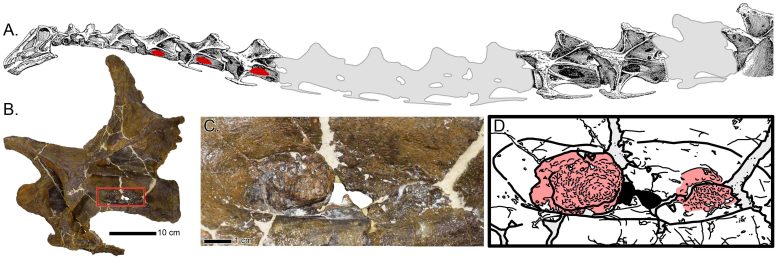Hypothetical life restoration of MOR 7029. Note that the pulmonary disease infecting this animal would not have been externally evident, but the probable pneumonia-like outward symptoms would have included coughing, labored breathing, nasal discharge, fever, and weight loss, among others. Credit: Woodruff, et al. (2022) and Corbin Rainbolt
The fossilized remains of a young diplodocid – a large, long-necked herbivorous sauropod – may provide the first evidence of a respiratory infection in a dinosaur, according to a study published in Scientific Reports. The findings increase our understanding of the illnesses that affected dinosaurs.

Abnormal bony growth in MOR 7029. (A) Schematic map of the neck of Diplodocus, with the abnormal bone growth denoted in red. (B) Neck vertebra of MOR 7029 with a red box highlighting the abnormal structure; close up in (C) with interpretative drawing in (D) (abnormal structure in red). Credit: Woodruff, et al.
The specimen, known as MOR 7029, was discovered in 1990 in southwest Montana, USA, and dates back to the Late Jurassic Period (approximately 150 million years ago). Cary Woodruff and colleagues examined three of the bones from MOR 7029’s neck and identified bony protrusions that had an unusual and irregular shape and texture. These protrusions were located in an area of each bone where they would have been attached to air-filled structures, known as air sacs. These air sacs would have connected to MOR 7029’s lungs and formed part of the dinosaur’s respiratory system. CT imaging of the irregular protrusions revealed that they were made of abnormal bone that most likely formed in response to an infection.

The elaborate and circuitous pulmonary complex of the sauropod, with the hypothetical route of infectious pathway in MOR 7029. Human scale bar is the profile of a man standing 170cm tall. Credit: Woodruff, et al., and Francisco Bruñén Alfaro
Based on the location of the abnormal bony protrusions, the researchers suggest that they formed in response to an infection in MOR 7029’s air sacs, which then spread into its neck bones. The authors speculate that this could have been caused by a fungal infection similar to aspergillosis, a common respiratory illness that affects birds and reptiles and can lead to bone infections. They suggest that if MOR 7029 had been infected with aspergillosis, it may have experienced flu or pneumonia-like symptoms such as weight loss, coughing, fever, and breathing difficulties. As aspergillosis can be fatal in birds if untreated, MOR 7029 could have ultimately died as a result of this infection, they add.
For more on this discovery, see Sauro-Throat! First Evidence Discovered Indicating Respiratory Infection in a Dinosaur.
Reference: “The first occurrence of an avian-style respiratory infection in a non-avian dinosaur” by D. Cary Woodruff, Ewan D. S. Wolff, Mathew J. Wedel, Sophie Dennison and Lawrence M. Witmer, 10 February 2022, Scientific Reports.
DOI: 10.1038/s41598-022-05761-3



0 Comments